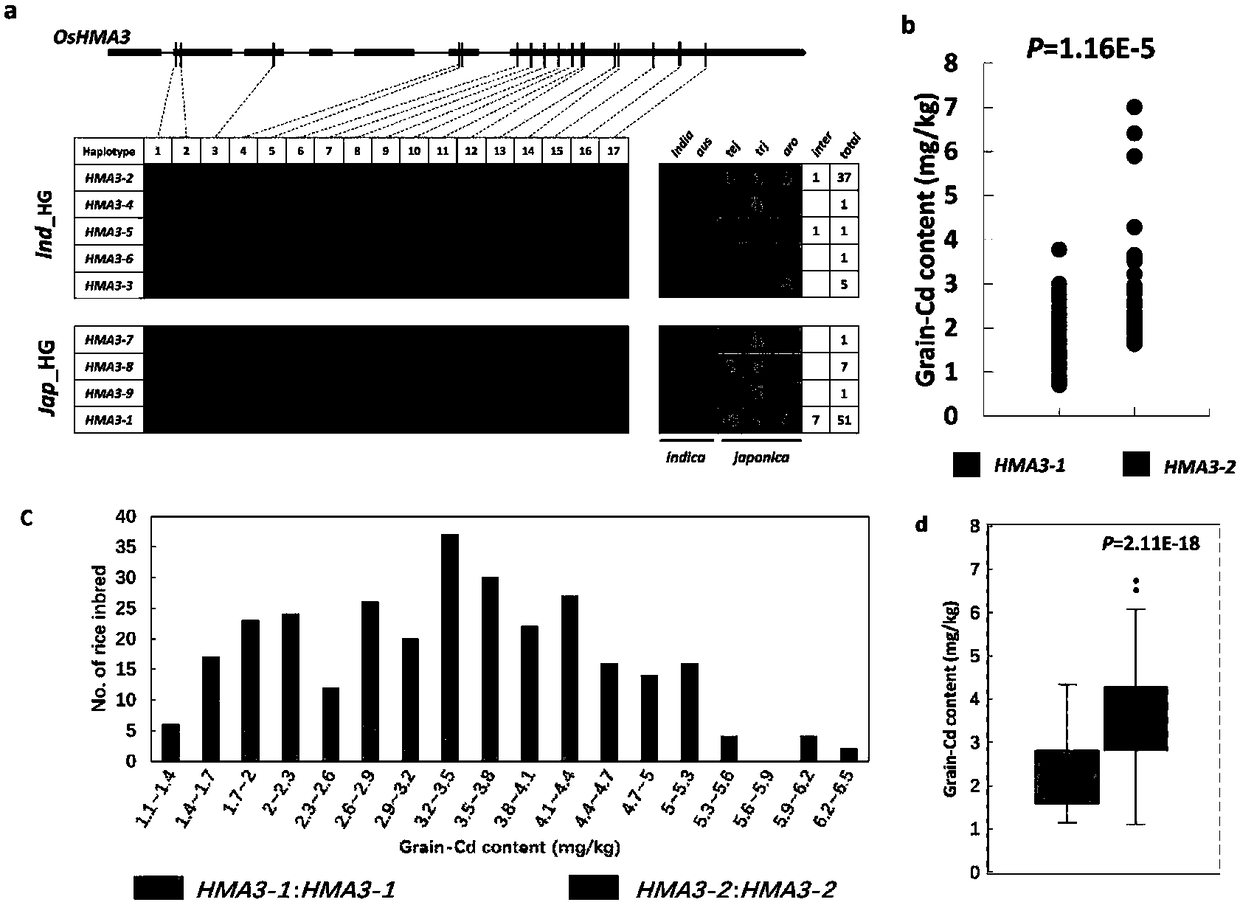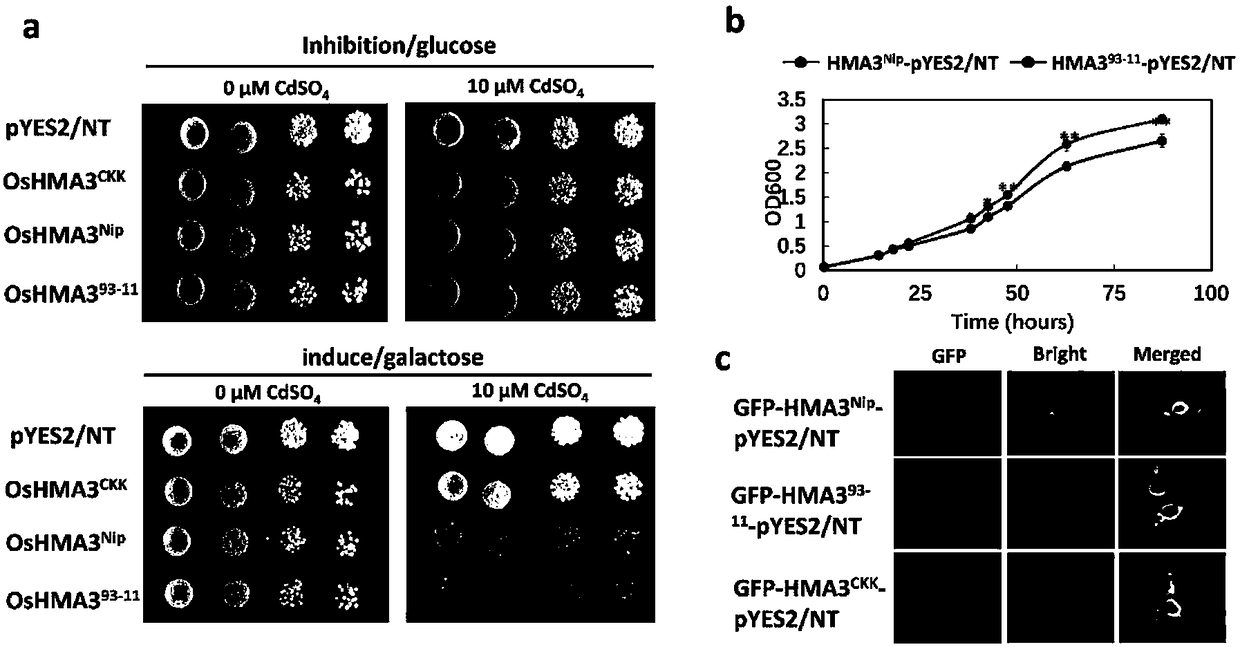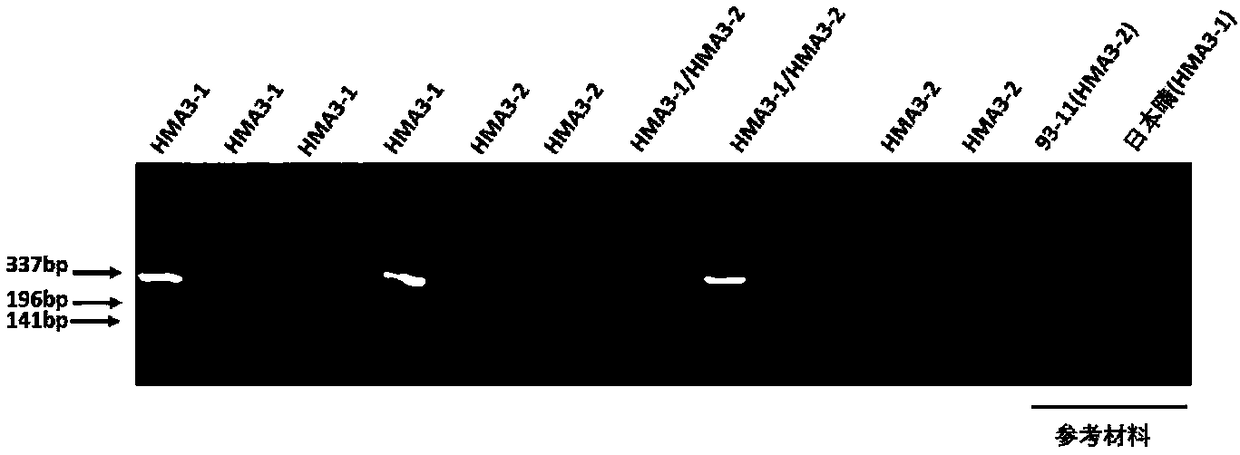Molecular marker Caps7 in paddy rice cadmium accumulation related gene OsHMA3 and application thereof
A molecular marker and rice technology, applied in the field of molecular biology, can solve the problems of high cadmium pollution and aggravate the risk of excessive cadmium content in rice, and achieve the effect of speeding up the breeding process
- Summary
- Abstract
- Description
- Claims
- Application Information
AI Technical Summary
Problems solved by technology
Method used
Image
Examples
Embodiment 1
[0031] Example 1: Discovery of allelic functional differences of HMA3 in rice indica and japonica subpopulations
[0032] (1) Natural variation of gene HMA3
[0033] Aiming at the rice cadmium accumulation-related QTL gene OsHMA3, the sequences of the OsHMA3 gene in 105 germplasm resources (collected in our laboratory) were analyzed. Haplotype analysis was carried out by MEGA sequence analysis software and STRUCTURE software, and it was found that there were 9 genotypes of this gene in nature, which were recorded as HMA3-1~HMA3-9 in sequence; among them, HMA3-2~HMA3-6 belonged to indica rice genes type, while HMA3-1, HMA3-7~HMA3-9 belong to the japonica rice genotype, see figure 1 a. HMA3-1 and HMA3-2 are the two main allelic genes, which accounted for 83.8% of the total materials; further analysis found that most of HMA3-1 appeared in japonica varieties and a small part appeared in indica varieties, while HMA3-2 The haplotype analysis of OsHMA3 mainly occurs in indica rice...
Embodiment 2
[0036] Example 2: Development of molecular marker Caps7 and genotype identification method
[0037] (1) Development of molecular marker Caps7
[0038] Molecular marker Caps7 of the present invention, the principle of marker design is: use the BLAST tool in the bioinformatics website NCBI (https: / / www.ncbi.nlm.nih.gov / ) to sequence the sequences of HMA3-1 and HMA3-2 Compare and find the difference site, the difference site forms two genotypes, wherein the one derived from the japonica rice genotype HMA3-1 cannot be cut by the restriction endonuclease AscI, after being digested by the AscI enzyme after PCR amplification, passed A single band was detected by agarose electrophoresis, and the size of the PCR product was 337bp; the indica rice genotype HMA3-2 could be cut by the restriction endonuclease AscI, and two bands were detected by agarose electrophoresis, and the size of the PCR product was 196bp and 141bp ,See image 3 .
[0039] (2) Genotype identification method
[0...
Embodiment 3
[0051] (1) Identification and screening of allelic types of the rice cadmium accumulation-related gene OsHMA3 in 300 rice indica materials and its effectiveness test
[0052] Taking the overall average value as the standard for distinguishing the high and low cadmium content of rice, the molecular marker Caps7 of the present invention was used to identify the allelic type of OsHMA3 in 300 indica rice materials.
[0053] The rice cadmium accumulation phenotypes of 300 materials were collected in polluted field experiments. The field planting method was carried out in a dry-wet alternate manner to maximize the accumulation of cadmium in the rice grains (the concentration of cadmium in the field is heavily polluted, the concentration is 1.9mg / kg, pH value is 5.4). Extract its genomic DNA from 300 parts of indica rice materials in Table 1, utilize the intragenic marker Caps7 of rice cadmium accumulation-related gene OsHMA3 (its PCR amplification primer is shown in SEQ ID NO:4 and ...
PUM
 Login to View More
Login to View More Abstract
Description
Claims
Application Information
 Login to View More
Login to View More - R&D
- Intellectual Property
- Life Sciences
- Materials
- Tech Scout
- Unparalleled Data Quality
- Higher Quality Content
- 60% Fewer Hallucinations
Browse by: Latest US Patents, China's latest patents, Technical Efficacy Thesaurus, Application Domain, Technology Topic, Popular Technical Reports.
© 2025 PatSnap. All rights reserved.Legal|Privacy policy|Modern Slavery Act Transparency Statement|Sitemap|About US| Contact US: help@patsnap.com



